Apple unveils powerful MacBook Pros, colourful HomePod minis & AirPods 3
Apple has unveiled new high end MacBook Pros, AirPods 3 and colourful HomePod minis at a video launch today.
Apple has announced high end 14-inch and 16-inch MacBook Pros with new powerful in-house developed computer chips designed for professionals and developers.
Third generation AirPods and a new colourful range of Siri-enabled HomePod mini speakers also were announced at what was the company’s second launch event in two months. The company released its iPhone 13 range last month.
Some anticipated that Apple would announce a souped-up Mac mini today. This did not happen.
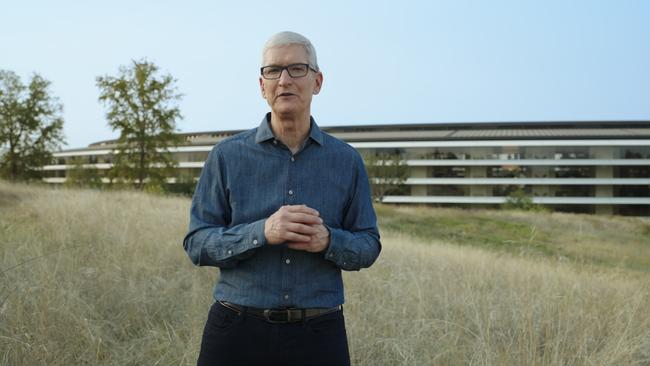
Apple is one year into a two-year transition from using Intel processors in its Macs to using its own developed processor architecture. The transition began with the release of a MacBook Pro, MacBook Air, and Mac mini desktop computer last year with Apple’s M1 chip.
The new entry level Apple range was well received. The three Macs proved to be surprisingly powerful with better battery life than their Intel powered antecedents, and at an affordable price. They featured what Apple termed the M1 processor and performed tasks you’d normally undertake on more expensive MacBooks.
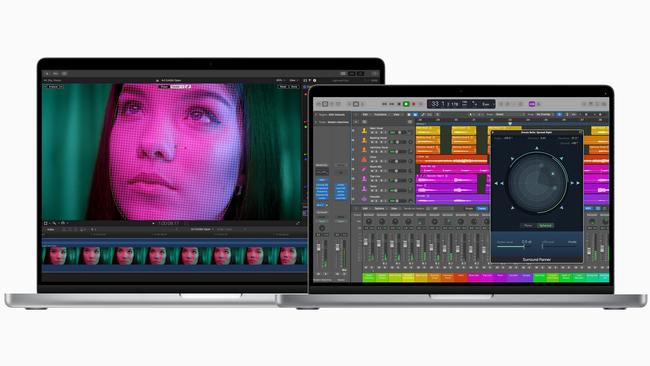
The move to home grown Apple Silicon chips saw changes to software as these ARM-based M1 chips were not capable of running some programs. But they were capable of running iPhone and iPad apps natively on a Mac. However, Apple produced a tool called Rosetta which would run older programs on the new Macs while software manufacturers such as Adobe developed and released M1-specific software versions.
The two new 14-inch and 16-inch MacBook Pro models announced today are not cheap. The 14-inch model starts at $2,999 and the 16-inch model begins at $3749. Discounts of $200 and $300 respectively are available for educational use and there is a trade-in program. You can pay up to $3749 for a 14-inch model and $5249 for a 16-inch model.
You can preorder now with the Pros going on market from October 26 at Apple Australia.

The secret to the power of these new Mac is their new system-on-a-chip architecture. Apple today released two chips – the M1 Pro and even more powerful M1 Max. The company announced a barrage of statistics and comparison to extol how good they are.
In essence, the M1 Pro delivers up to 70 per cent faster CPU performance than last year’s M1 on the entry level Macs, and up to two times faster GPU performance. M1 Pro also delivers up to 200 Gigabytes per second of memory bandwidth. The M1 Max uses the same CPU as the Pro but offers up to four time faster graphics performance than M1. It has up to 400 Gigabytes per second of memory bandwidth.
The Pro and Max CPUs consist of eight high-performance cores and two high-efficiency cores with the machines swapping load between them to enhance power when needed, and to preserve battery life when performing lighter tasks.
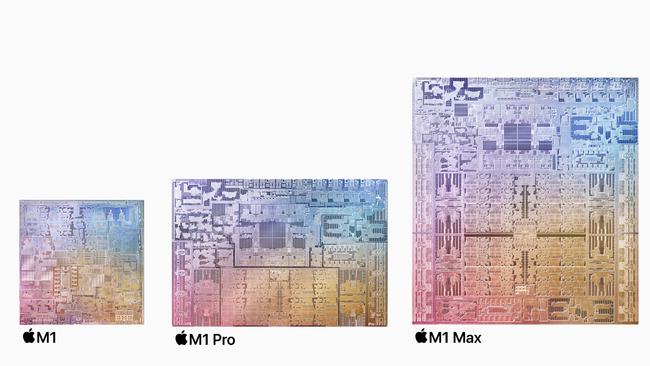
Apple claims much improved battery performance from the Macs – up to 17 hours of video playback on 14-inch models (up 7 hours), and up to 21 hours on 16-inch models (up 10 hours).
Both standard 14-inch MacBook Pros use the M1 Pro processor but you can request a bespoke configuration with the M1 Max; you get to pick either the M1 Pro or M1 Max on standard 16-inch models.
There are significant changes to the MacBook Pro architecture. The Touch Bar along the top row of the keyboard is gone; Apple has reverted to physical keys there, an acknowledgment that the Touch Bar feature just didn’t work out.
You also get a wider variety of connections around the edges – HDMI, Thunderbolt 4 USB-C and a full sized SD-card slot on one side, and two more Thunderbolt 4 ports and a headphone jack that supports high impedance headphones on the other.
The MagSafe magnetic connector for powering a MacBook is back in the form of MagSafe 3, although Apple says you can also power the new Macs through a Thunderbolt port.
You can connect up to 2 Apple Pro Display XDR monitors on MacBooks with an M1 Pro processor, and up to 3 Pro Display XDR monitors and a 4K TV at the same time with MacBooks sporting M1 Max chips. Apple says that represents 5 million pixels of screen real estate.
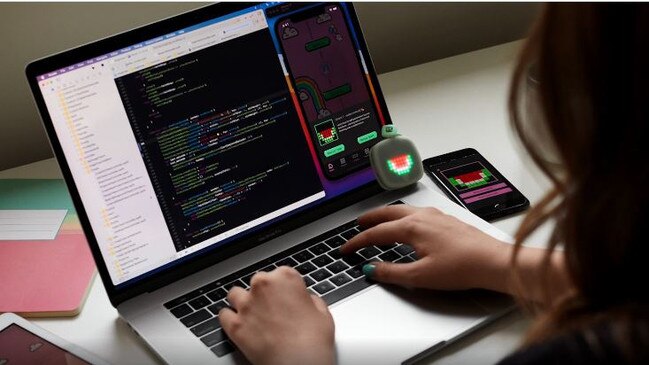
Both MacBook models boast bigger screens on smaller form factors, with the size of the bezel or border around the edges of the screen reduced to 3.5mm. As predicted, Apple has increased the usable screen area at the top of the Mac which means there is now a small bezel which houses a 1080p front facing camera. The menu bar wraps around it.
The result is that the 16-inch model has a 16.2-inch display, while the screen size on the 14-inch model is 14.2 inches. Both have what Apple terms a “liquid retina XDR display” with mini LED lighting that Apple adopted from the iPad Pro. Mini LED screens with thousands of tiny LEDs have been rolled out widely including by TV makers in 2021.
Both models will suit gamers with screen refresh rates of up to 120 Hertz for fast action gaming. Apple’s ProMotion feature can scale down the refresh rate to preserve battery life when performing less intensive tasks.
Improved heat management, and a 60 per cent reduction in the noise floor when listening to audio are among other improvements. The Macs also support Apple’s spatial audio when listening to music. Both models are available in space grey and silver from October 26.
AirPods 3
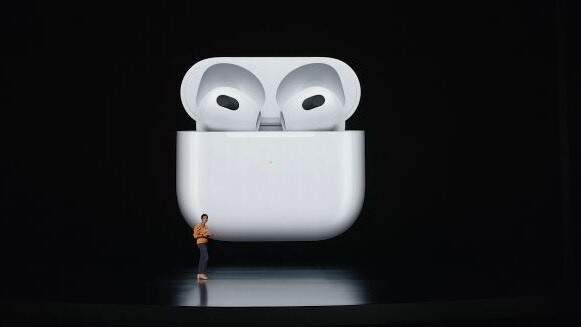
Music and audio also featured at the launch with Apple announcing a colourful range of HomePod minis and third generation AirPods. The new AirPods 3 support Dolby Atmos and spatial audio. It means you should get a sense of the direction of voices and instruments when you listen to spatial audio music on AirPods.
Apple says a new design directs sounds straight to your ears and the adaptive EQ feature adjusts the sound output by listening to the music as it enters your ears to offer more realism. Apple claims up to 6 hours of listening on a single charge with four additional charges from the case. That’s 30 hours overall. Five minutes of charge time will give you an hour of use, says Apple.
AirPods are sweat and water resistant, and you can charge the AirPods using either wireless charging or by attaching the case to one of Apple’s MagSafe charging devices released last year.
AirPods 3 cost $279 and will be available from October 26; AirPods 2 still available at $219. AirPods Pro will now also feature the new MagSafe charging case and remain at $399.

Apple says it has created hundreds of new playlists for different moods and activities. For example, you can ask Siri to put on a playlist for your dinner party, for relaxing and winding down, or for hiking. They are available to Apple Music subscribers.
Apple also announced a reduced price Apple Music plan known as the voice plan, costing $5.99 per month in Australia. The idea is that you use your voice to ask Siri to access content. The voice plan doesn’t include some features available on the individual and family plans, such as lyrics and music videos and spatial and lossless audio. You can’t use your own playlists, only Apple’s The voice plan will be available later this spring.
New Apple Music subscribers can get six months of Apple Music free with the purchase of any AirPods, AirPods Pro or AirPods Max.
The Siri-enabled HomePod mini speaker will be available in November in yellow, orange and blue, in addition to the existing white and space grey, for a recommended $149.
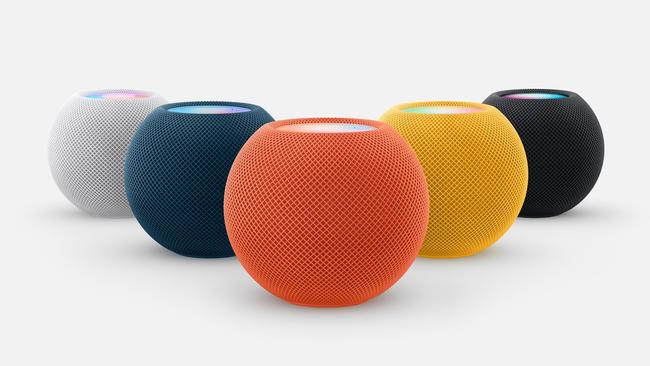



To join the conversation, please log in. Don't have an account? Register
Join the conversation, you are commenting as Logout